Hirudinea
(Leeches)
Number of families 14
Thumbnail description
Annelids possessing a caudal sucker used for attachment to surfaces, and a fixed number of body segments with subdivided annuli (ring-like structures); best known for their blood-sucking members and their use in medicine
Photo: Newborn brood of aquatic leaf leeches.
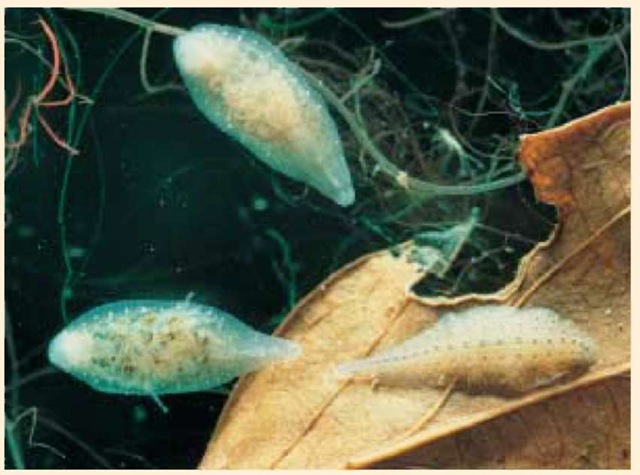
Evolution and systematics
Leeches are completely soft-bodied animals and could not be expected to leave a marked fossil record. Although there are two putative fossils from Bavarian deposits dating from the Upper Jurassic period (about 145 million years ago), Epi-trachys rugosus (Ehlers, 1869) and Palaeohirudo eichstaettensis (Kozur, 1970), neither has both the definitive caudal sucker and the ring-shaped subdivisions of the body that would define them as leeches. The evolutionary relationships of leeches demonstrate that the ancestral hirudinid was a blood feeder in a freshwater environment. This finding suggests that leeches are no older than vertebrates and probably no older than amphibians.
The phylogenetic relationships of leeches have been the subject of several analyses based on morphological (structural) characters and DNA sequence data. Taken together, these analyses demonstrate beyond question that leeches, branchiobdellidans (crayfish worms) and acanthobdellidans form a monophyletic (descended from a common taxon) group of oligochaetes that is closely related to the lumbriculid oligochaetes, or earthworms.
Leeches are subdivided first into suborders based on anatomical adaptations for feeding. The Rhynchobdellida, as their name implies, have a muscular proboscis that allows them to feed on blood drawn from tissues beneath an organism’s skin that are well supplied by blood vessels. The large worm-like Arhynchobdellida, of which Hirudo medicinalis is typical, have three muscular jaws, each of which may be armed with a row of teeth creating a serrated cutting edge.
The two principal families of proboscis-bearing Rhyn-chobdellida have pairs of medial cephalic eyespots that can detect two-dimensional movement. The Piscicolidae family comprises small elongate, mostly marine species that feed seasonally on fishes. The Glossiphoniidae tend to be strongly dorsoventrally flattened freshwater species typically preferring anuran (frogs and toads) or chelonian (turtles and tortoises) hosts, though a few are specific to fishes and others will feed on mammals.
The blood-feeding arhynchobdellids include the large aquatic Hirudinidae (medicinal leeches) and the smaller terrestrial Haemadipsidae (jungle leeches). The jungle leeches are more common in the humid forests of Southern Asia, India, Madagascar, Australia, and Indonesia than their aquatic cousins. Both of these groups are equipped with a parabolic arc of 10 eyespots that detect movement in three dimensions. Terrestrial leeches have the additional adaptation of respiratory auricles near their caudal sucker that permit gas exchange without excessive loss of fluid. These leeches also have well-developed sensory systems for detecting vibrations, carbon dioxide, and heat. In addition, there are several predatory arhynchobdellids like the slender Erpobdelliformes (families Erpobdellidae, Salifidae, and Americobdellidae); the larger amphibious Haemopidae; and several other poorly studied families.
Physical characteristics
Leeches have a clitellum, or specialized saddle-shaped glandular segment, that secretes cocoons or egg cases. These animals are simultaneous hermaphrodites. They have a body consisting of 34 body segments (somites) but lack the chaetae (stiff hairs or bristles) of other annelids. Though not all are sanguivorous, many leeches have special adaptations for blood feeding. Principal among these is the muscular caudal sucker made up of the last seven somites of the segmented body. The sucker is critical for attaching to and remaining on a host. It may double as a powerful swimming fluke (anchor) in larger and more active species. The six somites at the front of the leech also are modified into a region with a ventral sucker surrounding a muscular pharynx. Negative pressure applied by this anterior sucker aids in attachment and in encouraging blood to flow from a bite wound. Blood-feeding leeches usually are equipped with large branched gastric caeca, or pouches, that allow them to expand considerably during feeding; some leeches consume up to six times their unfed body weight. The fact that all present-day blood-feeding leeches have these features suggests that the ancestral leech also had them.
Distribution
Leeches can be found in one form or another in freshwater and terrestrial locations on all continents except Antarctica. Marine leeches are found in all oceans. The major families of leeches have global distributions with the exception of some species in the Haemadipsidae family. These species appear to have originated at the time of the late Gondwanan continental separation, after Africa and South America had parted from the remainder of the original su-percontinent about 180-140 million years ago. Some minor families, including the Americobdellidae and Cylicobdelli-dae, are found only in South America. Most oceanic leeches seem to prefer temperate or arctic waters, with only a few species specific to elasmobranchs being found in tropical marine systems.
Habitat
The frequency with which leeches are encountered depends on geography. Most species that occur in European, African, or North and South American freshwater ecosystems can be found under submerged rocks and debris or along shorelines when they are not feeding on their respective hosts. Terrestrial leeches are found only in such perpetually moist environments as tropical or temperate coastal rainforests, where they remain in leaf litter unless they are seeking a meal. The habits of marine leeches are not well understood, as they are most commonly encountered while they are feeding on fishes or turtles. Few leeches appear to select specific sites on the hosts they feed from.
Behavior
Many leeches can swim by coordinating the depolarization of nerve cells along their ventral cord, which causes the lon- gitudinal muscles to move the leech’s body in a curving or wavelike pattern. The posterior sucker serves as an anchor to provide thrust. Leeches move along solid substrates by alternating attachment of their anterior and posterior suckers between periods of body stretching— much like the movement of an inchworm. When at rest during long periods of digestion or while brooding young, leeches lie under objects along the shorelines, often partially out of water. They frequently are observed performing their wavelike swimming movement in place as though to assist in ventilation. Leeches have several anterior eyespots and are able to detect movement from contrasting patterns of light and shadow.
Feeding ecology and diet
Sanguivorous (blood-feeding) leeches are capable of living on blood because of a number of bioactive chemicals in their saliva. Vertebrate blood, including human blood, is equipped with coagulation (clotting) factors. Most leeches require 30 minutes or more for feeding; however, vertebrate blood can clot in much less time. If the blood that the leech ingests were to clot inside its digestive tract, it could not mate, avoid its predators, or seek another meal. Leeches have circumvented the endpoints of the mammalian coagulation cascade, which is the medical term for the process of blood clotting. The coagulation cascade includes the clumping of platelets, the production of a fibrin matrix (network), and the cross-linking of that matrix into a firm clot. Leeches can interfere with this clotting system at a minimum of seven different points. Hirudin, a potent thrombin inhibitor, was the first anticoagulant (blood-thinning) compound to be isolated from leech saliva. Most other leech-derived anticoagulants are also protease inhibitors.
Some sanguivorous species are very host-specific; Placobdel-loides jaegerskioeldi feeds exclusively on Hippopotamus amphibius, for example, while other leeches are less discriminating. Of the marine species, those that feed on cartilaginous fishes show no interest in teleosts (bony fishes), and Ozobranchus species feed only on turtles. In freshwater environments, the large and notorious hirudinid medicinal leeches more often acquire their nourishment from amphibians or fishes than from swimming humans.
Many leeches do not feed on blood at all. Glossiphoniids, like species of Helobdella and Glossiphonia, feed on aquatic oligochaetes and snails. The jawless Erpobdellidae feed on chironomid (midge) larvae, and the jawed haemopids consume whole earthworms, shredding them with jaws bearing two rows of large teeth. In addition, there are rarely encountered families like the South American Americobdellidae and Cyli-cobdellidae. The species in these families are terrestrial earthworm hunters and of uncertain phylogenetic affinities. Researchers have typically assumed that nonbloodfeeding varieties of leeches are more primitive than those with the “advanced” behavior of blood feeding. Recent phylogenetic work points to the existence of a blood feeding ancestor, however, and at least six transformations to predation in the history of leeches.
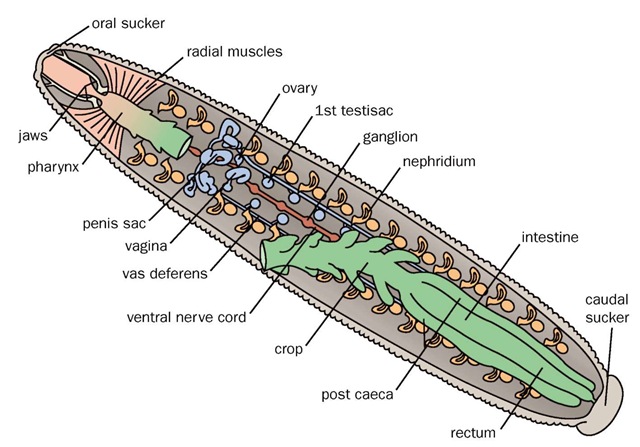
Leech anatomy.
Reproductive biology
Leeches are hermaphroditic animals with separate male and female reproductive systems. Male and female systems open independently to the exterior, each by means of a small ventral gonopore situated on the midventral line in the clitel-lar somites (normally somites XI through XIII). The most common form of sexual intercourse in leeches is traumatic insemination (direct injection into the female’s body cavity). Male leeches randomly implant their spermatophores (small packets containing sperm) in the cuticle or outer covering of a recipient mate. The larger hirudinids and terrestrial haemadipsids have anatomical adaptations for internal fertilization, including a protrusible penis and a receptive vaginal sac permitting direct contact between male and female gonopores.
Reproducing individuals are usually distinguishable by the swelling of a certain number of annuli in the region that includes their gonopores. This swollen area constitutes the clitellum, a glandular segment that secretes the cocoons or egg cases. Unlike the homologous structure in terrestrial earthworms, the degree of prominence of the clitellum varies considerably in leeches.
The fish leeches, or Piscicolidae, exhibit an adaptation that helps their offspring to find an early blood meal. Rather than abandoning a secreted cocoon as the oligochaetes and many leeches do, the piscicolids cement their egg cases to the surface of crustaceans. When a fish eats the crustacean, the young leeches readily attach to the fish host’s buccal (cheek) surfaces and migrate to its gills. Such Glossiphoniidae as Haementeria ghilianii are broad and flattened, and normally found feeding on turtles or amphibians. Species in this family secrete a membranous bag that holds their eggs on their underside in a brooding position underneath rocks and other debris. When the brood hatches, the young will turn and attach themselves to their parent’s venter, or belly. When the parent finds its next blood meal, the young are carried to their first blood meal.
Conservation status
The European medicinal leech, Hirudo medicinalis, has been overexploited. In addition, its natural habitat has become fragmented and highly restricted. This species is listed as Lower Risk/Near Threatened by the IUCN.
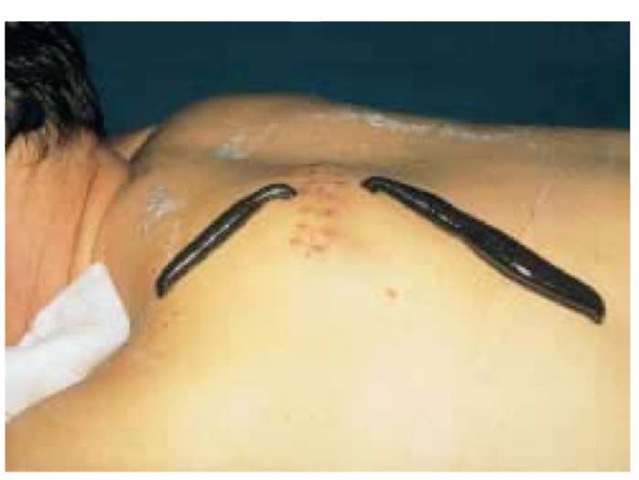
Use of the medicinal leech (Hirudo medicinalis) in the treatment of haemotoma, an accumulation of blood within the tissues that clots to form a solid swelling. The leech attaches its sucker near the injury, makes an incision and deposits an anticoagulant called hirudin, mixed with saliva, into the wound, breaking apart clots that are there, and preventing further clots from forming.
Many terrestrial rainforest species are as threatened as their specific habitats; examples include Mesob-della gemmata in the Valdivian coastal forests of Chile and Haemadipsa sumatrana.
Significance to humans
Leeches were well known for their medicinal applications in the eighteenth and nineteenth centuries, when they were used for such purposes as alleviating headaches and treating obesity. It is unlikely that any of these therapies were successful. Leeches are now, however, experiencing a renaissance of interest in medicine and pharmacology: they are the tools of choice for treating postoperative hematomas (localized collections of clotted blood) in microsurgery. In addition, their powerful salivary anticoagulants are being studied as possible treatments for heart disease and even cancer. Leeches are also potential indicator species for certain measurements of water quality, including heavy metal contamination and dissolved oxygen content.
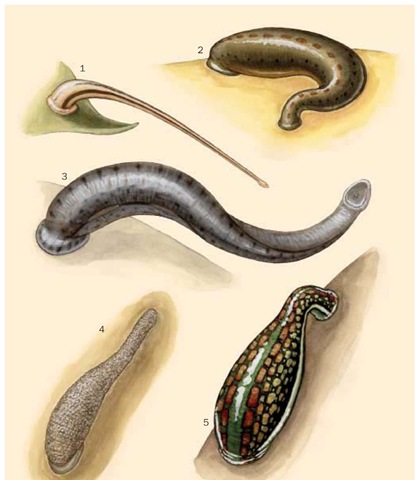
1. Tiger leech (Haemadipsa picta); 2. North American medicinal leech (Macrobdella decora); 3. Giant Amazonian leech (Haementeria ghilianii); 4. Hippo leech (Placobdelloides jaegerskioeldi); 5. Euopean medicinal leech (Hirudo medicinalis).
Species accounts
Tiger leech
Haemadipsa picta
ORDER
Arhynchobdellae
FAMILY
Haemadipsidae
TAXONOMY
Haemadipsa picta Moore, 1929.
OTHER COMMON NAMES
English: Jungle leech; terrestrial leech.
PHYSICAL CHARACTERISTICS
Pale brownish or orange body with a prominent paramedial pair of dark stripes of pigmentation on dorsum and irregular chain-link patterns medially. In its unfed state, it is normally 0.39-0.78 in (1-2 cm) in length and 0.16-0.19 in (4-5 mm) in width. When the leech is foraging and extended, cephalic somites form an obvious piriform (pear-shaped) shape like the head of a snake. Parabolic arc of 10 cephalic eyes arranged in five pairs. Three jaws in pharynx with fine denticles. Respiratory slits (auricles) are located along the sides near the caudal sucker.
DISTRIBUTION
Malesian subregion from southern Burma and southern China as far as Sumatra and Borneo.
HABITAT
Terrestrial in rainforests, especially in leaf litter. BEHAVIOR
Though poorly understood, the organism’s foraging is thought to involve an excellent ability to respond to movement as detected by its 10 eyespots, as well as the detection of carbon
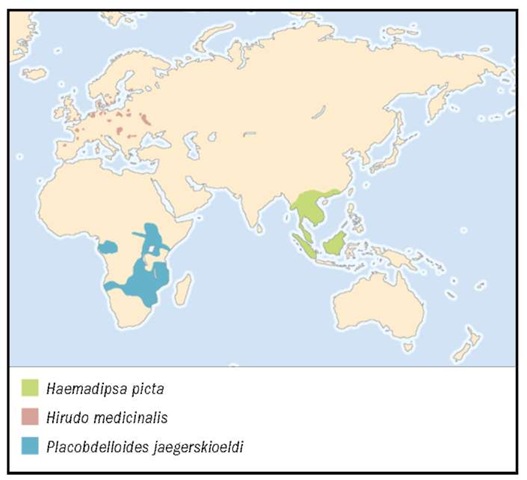
dioxide given off by nearby hosts. Mechanoreceptors on the skin of these leeches allow them to pursue movements on land similar to footsteps. They move quite rapidly over surfaces in an inchworm fashion.
FEEDING ECOLOGY AND DIET
Haemadipsids like the tiger leech forage on the ground, along the branches and leaves of underbrush and other exposed surfaces. They attach themselves to these surfaces by their larger caudal sucker and extend their bodies up or out, with the oral sucker ready to attach to a passing host. Though this species probably subsists on frogs, any passing mammal will serve for a suitable blood meal. Following a rainstorm, these leeches may number in the hundreds along trails and on brush; they can be quite oppressive to humans in the region.
REPRODUCTIVE BIOLOGY
Mating takes place through gonopore-to-gonopore copulation. The eggs are laid in clitellar secretions surrounding the body, which are then slipped over the head to form a protective egg case or cocoon left under leaf litter. Development is direct.
CONSERVATION STATUS
Not listed by the IUCN. Not enough is known about the population size of this leech. The tiger leech exists only in endemic rainforests, however, all of which are under grave threat in the regions where this species is found.
SIGNIFICANCE TO HUMANS
Where they occur, jungle leeches are among the most self-assertive and omnipresent elements of a rainforest. Although it is unlikely that anyone would bleed to death from the dozens of leeches that find their way into socks or under shirts and trousers, many have been driven to distraction by their tenacity, the inability to escape their attentions, or the itchy welts that may arise from their bites. Occasionally featured in motion pictures (e.g., Apocalypse Now).
European medicinal leech
Hirudo medicinalis
ORDER
Arhynchobdellae
FAMILY
Hirudinidae
TAXONOMY
Hirudo medicinalis Linnaeus, 1758.
OTHER COMMON NAMES
French: Sangsue medicinale; German: Medizinische Blutegel; Italian: Sanguisuga; Spanish: Sanguijuela medicinal; Swedish: Medicinsk blodigel.
PHYSICAL CHARACTERISTICS
Intricate red and green patterning on dorsum (upper surface), yellow medial lines, and tan venter (belly). Commonly grows up to 3.9 in (10 cm) or more in length and 0.39 in (1 cm) wide. Parabolic arc of 10 cephalic eyes arranged in five pairs.
Three jaws in pharynx with fine denticles (small toothlike structures).
DISTRIBUTION
British Isles, southern Scandinavia, continental Europe eastward to the Urals and to western Turkey. Distribution is very irregular and patchy as of 2003.
HABITAT
Found in naturally occurring freshwater lakes, ponds, streams, and marshes. Usually rests at air/water interface near shore.
BEHAVIOR
An excellent and agile swimmer, this leech can detect and move toward disturbances in the water from a distance of some yards. Vertical wavelike motions and use of the caudal sucker provide forward movement and thrust. Applies negative pressure to surfaces with its oral and caudal suckers for suction and attachment purposes.
FEEDING ECOLOGY AND DIET
Feeds principally on the blood of amphibians and fishes; occasionally feeds on mammals. Creates a three-part incision with its jaws and uses negative pressure of pharynx to draw out the upwelling blood. Can ingest quantities of blood several times greater than its unfed body weight. Can store blood in crop (enlarged area at the base of the esophagus) for months.
REPRODUCTIVE BIOLOGY
Mating takes place through gonopore-to-gonopore copulation involving an eversible penis and vaginal pouch. The eggs are laid in clitellar secretions surrounding the body, which are then slipped over the head to form a protective egg case or cocoon. Cocoons with approximately 10 eggs each are deposited on land near the edge of a body of water. Development is direct.
CONSERVATION STATUS
Overexploited; has seen its natural habitat become fragmented and highly restricted. Listed as Lower Risk/Near Threatened by the IUCN.
SIGNIFICANCE TO HUMANS
Used medicinally for the purpose of phlebotomy (drawing blood) for millennia, and popularized for this use in the nineteenth century. Most historical uses are of dubious utility. Current use in microsurgery to reduce postoperative hematomas is quite legitimate and effective. Commercially available for medical purposes. Several anticoagulants, such as the antithrombin compound hirudin, have been extracted from salivary tissues and have biomedical/pharmacological use. Occasionally featured in motion pictures (e.g., Speed 2).
North American medicinal leech
Macrobdella decora
ORDER
Arhynchobdellae
FAMILY
Macrobdellidae
TAXONOMY
Macrobdella decora Say, 1824.
OTHER COMMON NAMES
English: American leech.
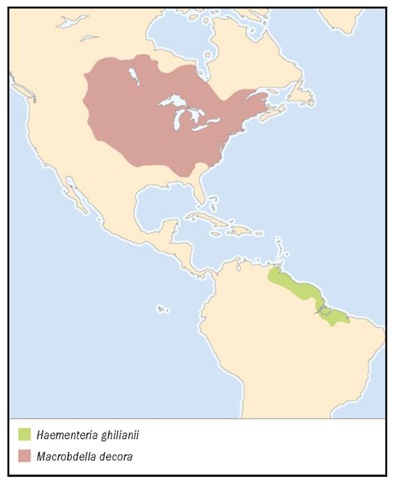
PHYSICAL CHARACTERISTICS
Olive dorsum with a medial row of orange spots on every fifth annulus and paramedial rows of black dots. Orange venter with two rows of prominent sexual gland pores behind the gono-pores. Commonly grows up to 3.9 in (10 cm) or more in length and 0.39 in (1 cm) wide. Parabolic arc of 10 cephalic eyes arranged in five pairs. Three jaws in pharynx with fine denticles.
DISTRIBUTION
North America; east of the Rocky Mountains from southern Canada to the Carolinas and along the Mississippi River drainages.
HABITAT
Found in naturally occurring freshwater lakes, ponds streams and marshes. When resting, usually found at the air/water interface near shore.
BEHAVIOR
An excellent and agile swimmer, this species can detect and move toward disturbances in water from a distance of some yards. Vertical wavelike motions and use of the caudal sucker provide forward movement and thrust. Oral and caudal suckers apply negative pressure to surfaces for suction and attachment purposes.
FEEDING ECOLOGY AND DIET
Feeds principally on the blood of amphibians and fishes; occasionally feeds on mammals. Creates a three-part incision with its jaws and uses negative pressure of the pharynx to draw out the upwelling blood. Can ingest quantities of blood several times greater than its unfed body weight. Can store blood in crop (enlarged area at the base of the esophagus) for months.
REPRODUCTIVE BIOLOGY
Mating is through gonopore-to-gonopore copulation but penis and vagina are quite small relative to those of its European counterpart. The eggs are laid in clitellar secretions surrounding the body, which are then slipped over head to form a protective egg case or cocoon. Cocoons with approximately 10 eggs each are deposited on land near the edge of a body of water. Development is direct.
CONSERVATION STATUS
Not listed by the IUCN. Populations are usually abundant when encountered.
SIGNIFICANCE TO HUMANS
Features prominently in creation mythology of the Osage tribe of Native Americans. Antiplatelet aggregation factor, decorsin, isolated from salivary secretions. Not widely used for phlebotomy. Occasionally featured in motion pictures (e.g., Stand by Me).
Giant Amazonian leech
Haementeria ghilianii
ORDER
Rhynchobdellida
FAMILY
Glossiphoniidae
TAXONOMY
Haementeria ghilianii de Phillipi, 1849.
OTHER COMMON NAMES
French: Sangsue amazonienne.
PHYSICAL CHARACTERISTICS
Perhaps the largest freshwater leech, this species can exceed 11.8 in (30 cm) long and 3.93 in (10 cm) wide. The species is dorsoventrally flattened and shaped like a lance with a large caudal sucker. Adults often appear simply dark gray-brown in color, though younger specimens have a characteristic dorsal median broken stripe and other regular pigment patches on every third annulus. The somites in the head region carry one pair of eyes.
DISTRIBUTION
Found in locations near the mouth of the Amazon River, as far north as Venezuela and throughout the Guianas.
HABITAT
Coastal wetland marshes.
BEHAVIOR
A capable swimmer, this species is more often found on the underside of submerged rocks or debris where it hides while digesting a blood meal or brooding young.
FEEDING ECOLOGY AND DIET
Often found feeding on introduced cattle, this species otherwise feeds on endemic amphibians when young and on such local aquatic vertebrates as caimans, anaconda, and capybara. This leech feeds by inserting a muscular proboscis into the tissues of the host from which vascular blood is then pumped into its gastric pouches.
REPRODUCTIVE BIOLOGY
Mating is carried out by traumatic insemination of sper-matophores into the integument (skin-like covering) of a recipient leech. Fertilized eggs are deposited on the underside of the parent and brooded until they hatch. The young are then carried to their first blood meal by the parent leech.
CONSERVATION STATUS
Not listed by the IUCN. Although this leech is difficult to find, it is not protected in any way.
SIGNIFICANCE TO HUMANS
The anticoagulant compound hementin, isolated from the salivary secretions of the giant Amazonian leech, is capable of breaking down a blood clot after it has formed. Hementin may be useful in medical treatment if it does not trigger allergic reactions from the patient’s immune system during chronic use. Another anticoagulant compound known as tridegin has also been isolated from the secretions of H. ghilianii.
Hippopotamus leech
Placobdelloides jaegerskioeldi
ORDER
Rhynchobdellida
FAMILY
Glossiphoniidae
TAXONOMY
Placobdelloides jaegerskioeldi Johansson, 1909.
OTHER COMMON NAMES
None known.
PHYSICAL CHARACTERISTICS
Dorsoventrally flattened and shaped like a lance with a large caudal sucker. Adults have a rough body surface due to the presence of large numbers of tubercles (small nodules). Color is dull brown to light gray with orange ringlets arranged in transverse rows. The somites in the head region carry one pair of eyes.
DISTRIBUTION
Found throughout sub-Saharan Africa wherever there are hippopotami.
HABITAT
In pools and pans frequented by hippos; in particular, inside the rectum of the animals themselves.
BEHAVIOR
Very sluggish, not a strong swimmer. Movement is mostly by alternate use of suckers.
FEEDING ECOLOGY AND DIET
This species is the only leech that is specific to a mammalian host. It feeds by inserting its proboscis into the rectal tissues of a hippopotamus, where it feeds to the point of fullness and mates with other leeches.
REPRODUCTIVE BIOLOGY
Mating is carried out by traumatic insemination of spermatophores into the integument of a recipient leech. Fertilized eggs are deposited on the underside of the parent and brooded until they hatch. Brooding is believed to occur outside the hippopotamus host. The young are then carried to their first meal in the rectum of the next hippopotamus by the parent.
CONSERVATION STATUS
Not listed by the IUCN.
SIGNIFICANCE TO HUMANS
So far this species is poorly studied but may prove interesting to medical researchers in light of its being specifically adapted to counteract the mammalian blood clotting system.
